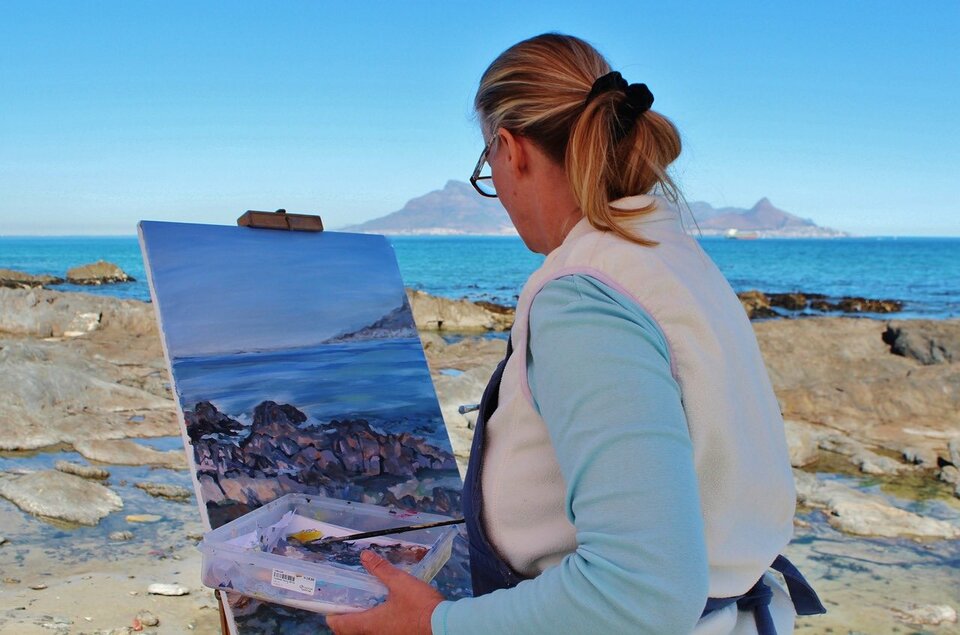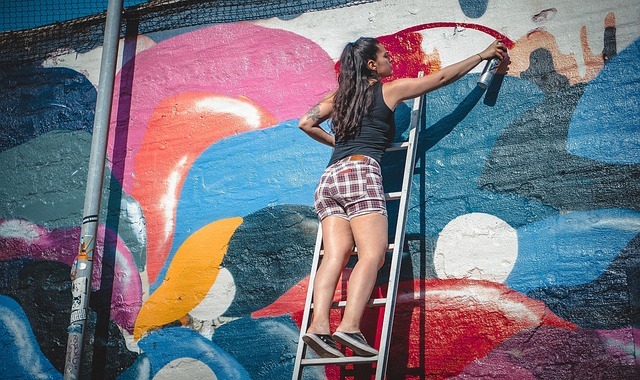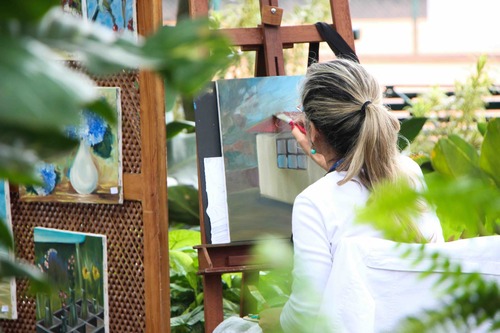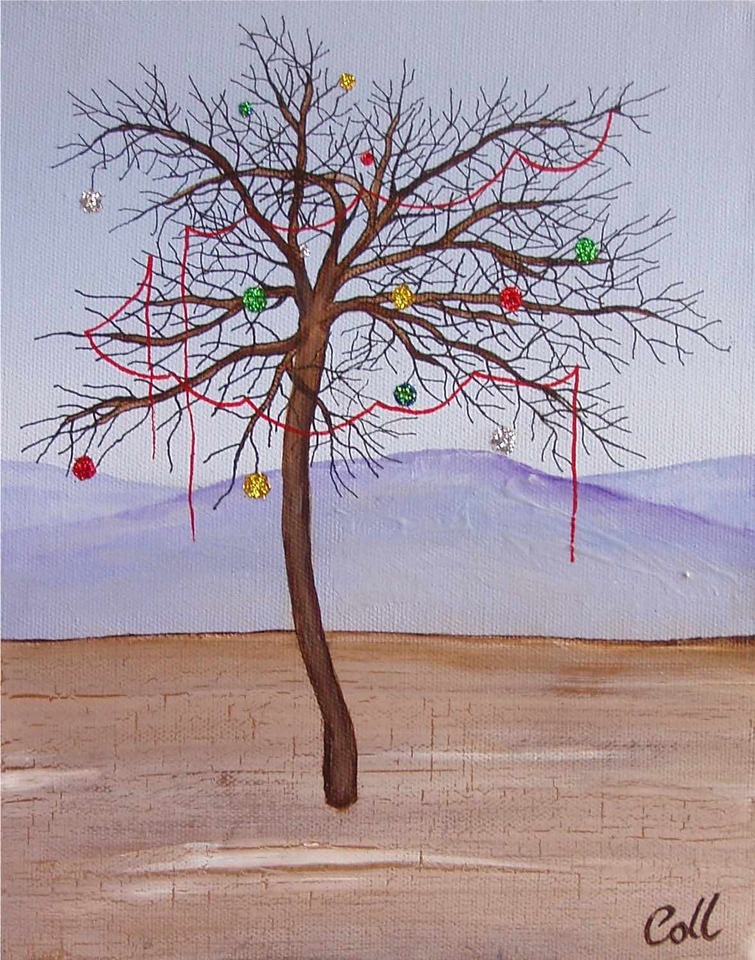New Zealand Female Visual Artists
It's no secret that in the vast canvas of art history, the contributions of female artists often remain overshadowed by their male counterparts. The names of Leonardo Da Vinci, Pablo Picasso, and Claude Monet echo through time, as well as our own New Zealand male artists such as C.F. Goldie, Ray Hammond, Ralph Hotere, Micheal Smither, Colin McCahon and Grahame Sydney, just to name a few.
Yet, the stories of female artists resonate just as profoundly. As a New Zealand female artist, let me share some of the remarkable women (in no particular order) who have made their mark on our country, a country that has a plethora of creative talent.
From the passionate brushstrokes of Frances Hodgkins to the politically charged canvases of Emily Karaka, these women have shaped the visual arts landscape, adding vibrant hues and unique perspectives to the rich tapestry of New Zealand's artistic heritage. Let's take a look at each one:
Frances Hodgkins: A Trailblazer in Freely Painted Works
Born in Dunedin, New Zealand, in 1869, Frances Hodgkins emerged as a trailblazing force in artistic innovation. Her early years were marked by a thirst for creative expression, a trait that would define her prolific career.
Hodgkins' artistic journey took a fascinating turn when she dug deep into the world of freely painted works later in life. This marked a departure from convention, as she embraced a style that allowed her creativity to flow unrestrained onto the canvas. The result was a body of work that showcased technical mastery and carried the emotional depth of an artist unshackled by traditional norms.
An intriguing facet of Hodgkins' artistic legacy is her connection to Henri Matisse, a prominent figure in the European art scene. This artistic lineage added an international flavour to her body of work, influencing her techniques and contributing to the unique amalgamation of styles in her paintings.
Frances Hodgkins' impact on the New Zealand art scene cannot be overstated. She was not merely an observer of artistic trends but a pioneer who challenged the status quo. Her works resonated with viewers, capturing the essence of the human experience with each stroke of her brush.
The artist's journey came to a poignant end in 1947, but her legacy lives on as an indelible mark on the canvas of New Zealand art history. Hodgkins' exploration of freely painted works is an enduring inspiration for contemporary artists, reminding them of the power that lies in breaking artistic boundaries and embracing creative liberation.
Robyn Kahukiwa: A Stalwart Advocate of Contemporary Maori Art on the Global Stage
Originating from Sydney, Robyn Kahukiwa transitioned to New Zealand in the late 1950s, marking the commencement of a remarkable journey as a steadfast champion of Contemporary Maori art.
Situated in Rotorua, Kahukiwa's artistic endeavours have transcended regional boundaries, establishing her as a pivotal figure whose influence resonates globally. Her tireless efforts have not only raised awareness but have also positioned her works in esteemed museum collections worldwide.
Kahukiwa's commitment to Contemporary Maori art goes beyond the canvas; it is a testament to her unwavering dedication to amplifying Maori voices on an international platform. Her artistic narratives unfold as compelling stories that bridge cultural divides, shedding light on the richness of Maori heritage and the contemporary issues that shape its evolution.
Situated in Rotorua, a place steeped in Maori culture, Kahukiwa's work reflects the vibrant traditions and narratives that define the Maori experience. Her artistic practice is imbued with a sense of purpose — to challenge stereotypes, preserve cultural identity, and contribute to the ongoing dialogue between tradition and modernity.
The global recognition that Kahukiwa has garnered is a testament to the universality of her themes. Her works, which have found homes in significant museum collections worldwide, serve as ambassadors of Maori culture. Through her art, she invites audiences to engage with the complexities of Maori identity, encouraging a deeper understanding of the cultural differences embedded within each brush stroke.
Beyond the confines of New Zealand, Kahukiwa's artistic legacy becomes a bridge that connects diverse audiences with the narratives of the Maori people. Her role as a stalwart advocate extends beyond the canvas, fostering cross-cultural conversations and contributing to the global tapestry of Contemporary Maori art.
In exploring Robyn Kahukiwa's works, we encounter an artist and a cultural ambassador whose brushstrokes traverse borders, creating a lasting impact on the global stage. Her journey reflects a profound commitment to art as a catalyst for understanding, empathy, and celebrating diverse cultural narratives.
Rita Angus: A Modernist Visionary with Distinctive Brilliance
Born in 1908, Rita Angus stands as a pivotal figure in the landscape of New Zealand's modernist art movement. Her artistic legacy extends far beyond the confines of time, leaving an indelible mark on the canvas of New Zealand's cultural heritage.
Her distinctive use of sharp lighting and flattened outlined forms is at the heart of Angus' innovative approach. These characteristics set her apart from her contemporaries and encapsulate the essence of a visionary artist pushing the boundaries of traditional artistic expression.
Angus' works are a testament to her keen perception of the interplay between light and form. The sharp lighting she employed added a dynamic quality to her paintings, creating a sense of depth and movement that engaged viewers on a profound level. The flattened outlined forms, another hallmark of her style, lent a modernist sophistication to her compositions, establishing her as a pioneer in the evolving narrative of New Zealand art.
Her impact on the modernist art movement reverberated throughout her career, showcasing a consistent commitment to pushing artistic boundaries. Angus' paintings not only reflected the climate of her era but also anticipated the evolving trends in contemporary art.
The echoes of Rita Angus' contributions continued until her passing in 1970. Her life's work, characterised by its innovative spirit and distinctive brilliance, has solidified her position as a vital contributor to the rich tapestry of New Zealand's artistic heritage. Beyond her creative prowess, Angus' legacy is an enduring source of inspiration for artists navigating the ever-evolving landscape of modernist expression in New Zealand and beyond.
I've been fortunate to see an exhibition celebrating Rita Angus' work at the Dunedin City Art Gallery where I feel in love with her work. Just like the first time I saw Van Gogh's work in Paris I never fully understod it until I stood in front of the real thing. It inspired a collection in my own work based around Rita's watercolour titled ' Tree.' here is one of my pieces:
Louise Henderson: A Cubist Maestro in the New Zealand Art Scene
Dame Louise Etiennette Sidonie Henderson, born in Paris in 1902, etched her name into the annals of New Zealand's art history as a maestro of cubist painting. Her journey from Paris's vibrant art scene to New Zealand's shores marked a transformative chapter in the country's cultural narrative.
Immigrating in 1923 with her Kiwi husband, Henderson brought with her the avant-garde spirit of cubism, a movement that had captivated the European art scene. Her arrival injected a fresh perspective into New Zealand's artistic landscape, setting the stage for a career that would earn her recognition as a leading Modernist painter.
At the core of Henderson's artistic philosophy was the exploration of form and structure through the lens of cubism. Her paintings resonated with geometric precision, capturing the essence of her subjects in a mosaic of shapes and angles. This departure from traditional representational art was not just a stylistic choice but a bold statement that reflected the dynamism of the modern era.
In 1973, the artistic community acknowledged Henderson's outstanding contribution with the prestigious Queen Elizabeth II Arts Council fellowship. This recognition was a testament to her enduring impact on New Zealand's artistic landscape. The fellowship not only celebrated her past achievements but also provided a platform for continued exploration and innovation.
Dame Louise Henderson's legacy extends beyond the canvas; it is a testament to the transformative power of artistic migration. Her cubist masterpieces continue to inspire contemporary artists, reminding them of the profound impact that bold experimentation can have on shaping a nation's cultural identity.
Gretchen Albrecht: Abstract Visionary and Color Maestro
Born in Onehunga in 1943, Gretchen Albrecht emerges as a luminary in contemporary New Zealand art, celebrated for her profound contributions to abstraction. Albrecht's artistic journey unfolds as a vibrant tapestry woven with bold strokes of colour, expressive gestures, and innovative forms that have left an indelible mark on the country's artistic legacy.
At the heart of Albrecht's acclaim lies her mastery of abstract expression. Her canvases are not just painted; they are symphonies of colour that dance across the surface, evoking emotions and sparking contemplation. Each carefully placed stroke contributes to a larger narrative of artistic exploration and experimentation.
One of the defining characteristics of Albrecht's body of work is her ingenious use of colour. The palette she employs is not just a visual feast; it is a language, a means of communicating emotions and transcending traditional representational boundaries. Her ability to coax meaning from the interplay of hues elevates her work to a realm where abstraction becomes a powerful conduit for conveying the ineffable.
The choice of canvas shape is another distinctive feature of Albrecht's artistic vocabulary. To explore her ideas, she chooses lunettes (half circles) and oval canvases. These unconventional forms offer a dynamic space for her compositions, challenging the rectangular confines of tradition and adding an additional layer of intrigue to her abstract narratives.
Gretchen Albrecht's impact on New Zealand art is profound and enduring. Her works, characterised by their vibrant energy and intellectual depth, have solidified her place in the annals of New Zealand's artistic history and set a standard for future generations of abstract artists. As we examine the hues and contours of Albrecht's creations, we witness an artist who has not just painted pictures but has woven a rich, visual symphony that resonates with the very soul of abstraction.

Emily Karaka: Fusion of Identity and Activism in Art
Born in 1952, Emily Karaka is a commanding figure in the New Zealand art scene, her work serving as a potent intersection of political activism, Maori identity, and artistic expression. As a political artist, Karaka's creations become more than visual compositions; they evolve into profound statements, echoing the struggles and aspirations of the Maori people.
Karaka's artistic language is a fusion, a harmonious blend of traditional Maori forms and the vibrant palette of European Expressionism. This synthesis results in artworks that captivate the eye and speak to the complex interplay between cultural heritage and the broader sociopolitical context.
At the heart of Karaka's body of work lies a powerful assertion of Maori identity. Her canvases are imbued with the narratives of The Treaty and land rights, issues of profound significance in the Maori community. Through her art, Karaka becomes a storyteller, using visual symbols and vibrant colours to communicate the intricate layers of history, struggle, and resilience embedded in Maori culture.
The 1980s witnessed a surge in the Maori art movement. Emily Karaka emerged as a pivotal figure within this cultural renaissance. Her contributions went beyond the canvas; they became a catalyst for dialogue and introspection, sparking conversations about indigenous rights and the importance of preserving cultural heritage.
Karaka's bold and unapologetic art is a testament to the transformative power of creativity in the face of social and political challenges. Her works encourage viewers to engage with the complexities of Maori identity, challenging preconceptions and fostering a deeper understanding of the issues that resonate within the indigenous community.
As we navigate the vibrant strokes and symbolic forms of Emily Karaka's creations, we are invited not only to appreciate the aesthetic brilliance but also to partake in a larger conversation about identity, activism, and the enduring role of art as a vehicle for social change.
Lois White: Rediscovering a Distinctive Voice in Figurative Painting
In the ever-evolving landscape of New Zealand art, Lois White (1903–1984) emerges from the shadows of relative obscurity, her journey marked by a fascinating interplay of artistic influences, resilience, and a reevaluation of her work in contemporary contexts.
Influenced by the Art Deco movement, White's early career unfolded against the backdrop of a dynamic period in art history. The geometric forms, bold lines, and visual dynamism of Art Deco left an indelible mark on her artistic sensibilities, shaping the foundations of her creative expression.
Despite her affiliation with a significant artistic movement, White faced a period of relative obscurity during the mid-20th century. The prevailing trends and preferences of the time overshadowed her distinctive voice, relegating her contributions to the margins of the art scene.
However, the tides of artistic appreciation are ever-shifting, and Lois White's narrative experienced a renaissance with the resurgence of figurative painting. The renewed interest in the human form and narrative storytelling in art led to a critical reevaluation of her work, bringing her out of the shadows and into the spotlight.
Once overlooked, Lois White is now recognised as one of New Zealand's most distinctive artists. Her figurative paintings, characterised by a unique blend of pattern, simplified form, and the impression of movement, resonate with a timeless quality that transcends the temporal confines of artistic trends.
As we revisit White's works, we engage not only with the aesthetic allure of her paintings but also with a rediscovery of an artist who defied obscurity. Her journey is a testament to the cyclical nature of artistic appreciation, where reevaluating an artist's body of work can reveal hidden gems and contribute to a more varied understanding of New Zealand's artistic tapestry. Lois White's legacy, once eclipsed, now stands as a beacon of resilience and creativity, awaiting exploration and recognition in the ever-expanding narrative of New Zealand art.
Philippa Blair: Navigating Dimensions with Conceptual Abstraction
Born in Christchurch in 1945 and currently based in California, Philippa Blair emerges as a pioneering figure in 'conceptual abstraction.' Her artistic journey unfolds as a dynamic exploration of dimensions, pushing the boundaries of traditional artistic forms.
Blair's approach to art transcends the two-dimensional confines of traditional canvases. Instead, she dives into three-dimensional works, creating a visual language that challenges conventional perceptions. Her innovative use of folded canvases and book formats becomes a canvas in itself, allowing her to navigate the intricate interplay between space, form, and concept.
'Conceptual abstraction' becomes the hallmark of Blair's artistic philosophy. Her works are not merely visual compositions but explorations of ideas, processes, and mythologies. Each piece becomes a visual dialogue, inviting viewers to contemplate the aesthetics and the intellectual and emotional dimensions embedded within.
Blair's canvases, folded and unfolded, become a metaphor for the layers of meaning she weaves into her art. Her work becomes a rich tapestry of exploration, from process-based ideas to mythological narratives, a journey through the realms of imagination and intellect.
As an artist straddling the physical distance between New Zealand and California, Blair's creations bridge the gap between cultures, inviting viewers to transcend geographical boundaries and engage with the universality of conceptual expression. Her art becomes a conduit for connecting diverse perspectives, making her a contemporary explorer in the global landscape of artistic innovation.
Philippa Blair's foray into conceptual abstraction not only challenges artistic conventions but also invites us to reconsider the very essence of art. Her folded canvases are not just visual experiments; they are portals into a realm where ideas unfold, myths come to life, and the very fabric of artistic expression takes on new dimensions.
Judy Darragh: Transforming Consumer Detritus into Artistic Commentary
Born in 1957 and based in Auckland, Judy Darragh emerges as a visionary artist who, with a keen eye and a touch of whimsy, reshapes the detritus of consumer society into glorious sculptural assemblages. Her unique approach to art transforms discarded objects into visual narratives. It serves as a thought-provoking commentary on the wastefulness of contemporary culture.
Darragh's artistic palette is the remnants of our consumer-driven world. Everyday objects, often overlooked and discarded, find new life in her hands. The discarded become the medium for her creativity, and the mundane transforms into the extraordinary as she repurposes these items into whimsical sculptures that challenge traditional notions of art.
Her assemblages, displayed in museums, become immersive experiences. Darragh's meticulous curation of consumer detritus transforms exhibition spaces into whimsical realms where the discarded is celebrated, and the ordinary becomes extraordinary. Each piece, carefully composed, highlights the poignant wastefulness embedded in the fabric of contemporary culture.
Beyond the visual allure, Darragh's work is a powerful social commentary. Her sculptures, often featuring everyday objects, national icons, and symbols of mass production, prompt viewers to reflect on the throwaway nature of modern society. In transforming the overlooked into the focal point, she invites us to reconsider our relationship with consumerism and the environmental impact of our disposable culture.
Judy Darragh's artistic journey extends beyond the boundaries of traditional art forms, challenging perceptions and sparking conversations. Her ability to turn detritus into glorious displays showcases her artistic prowess. It reflects the interconnectedness of art, culture, and societal values. As we engage with her whimsical creations, we are invited to navigate the profound intersection of artistic expression and the contemporary human experience.

Lisa Reihana: A Visionary Explorer of Cultural Identity through Technology
Born in 1964, Lisa Reihana emerges as a trailblazing figure in contemporary New Zealand art. Her work seamlessly blends technology, video installations, and a profound exploration of cultural identity. Her interdisciplinary approach and innovative use of media have positioned her as a visionary artist whose work transcends traditional boundaries.
Reihana's canvas extends far beyond the physical; it incorporates the digital realm, where she harnesses the power of technology to create immersive and thought-provoking experiences. Her video installations serve as portals into narratives that unfold and evolve dynamically, engaging viewers on both an intellectual and emotional level.
Central to Reihana's artistic exploration is a thematic focus on cultural identity and history. Her work becomes a visual discourse, delving into the complexities of heritage, tradition, and the intersection of diverse cultural narratives. Through the lens of technology, she invites audiences to navigate the intricate layers of identity, inviting a deeper understanding of the rich tapestry that makes up the cultural fabric of New Zealand.
The innovative use of technology in Reihana's art is not a mere tool but an integral part of the narrative. She employs cutting-edge techniques to challenge conventional storytelling, creating an immersive experience that transports the viewer into a world where history and contemporary culture coalesce. This dynamic fusion becomes a vessel for exploring the varied differences of identity in an ever-changing world.
Reihana's interdisciplinary approach places her at the forefront of artists who utilise technology to expand the possibilities of artistic expression. Her contributions extend beyond the gallery space, resonating in the digital spheres where she engages with global audiences, fostering conversations about cultural diversity and shared histories.
When we examine Lisa Reihana's work, we see how she uses the tools of the future to build bridges between the past and the present. Through her visionary use of technology and exploration of cultural themes, Reihana propels New Zealand art into new dimensions, inviting us to reflect on the ever-evolving narratives that shape our collective identity.
Robin White: Bridging Cultures and Nurturing Environmental Reflections
Born in 1946, Robin White is a prominent figure in the New Zealand art scene. She contributes significantly to the contemporary landscape through her insightful explorations of cultural exchange and environmental concerns. Her art becomes a canvas where nuanced reflections on the intersection of cultures and humanity's impact on the environment unfold.
White's body of work is characterised by a deep engagement with themes of cultural exchange. Her artistic lens serves as a bridge between diverse worlds, fostering a visual dialogue that transcends geographical boundaries. Through her work, she explores the interconnectedness of different cultures, celebrating the richness that emerges when diverse perspectives converge.
In White's art, cultural exchange is not merely a subject but a dynamic process. Her compositions become narratives of shared experiences where traditions, stories, and symbols intertwine. The tapestry she weaves reflects the evolving nature of cultural relationships, inviting viewers to contemplate the beauty and complexity that emerge when cultures interact and influence one another.
Environmental concerns also feature prominently in White's work. Her art becomes a poignant reflection on the impact of human activity on the natural world. Through her visual storytelling, she raises awareness about environmental issues, prompting viewers to consider the delicate balance between human existence and the ecosystems we inhabit.
White's approach is marked by a commitment to authenticity. She often immerses herself in the communities she portrays, forming personal connections that enrich her artistic narratives. This authenticity infuses her work with a profound depth, inviting viewers not only to witness cultural exchange and environmental reflections but to empathise with the human stories embedded within.
As we navigate the canvases of Robin White, we go on a journey that transcends the boundaries of art, culture, and environmental consciousness. Her contributions to the contemporary art scene serve as a reminder of the power of art to foster understanding, bridge divides, and instigate meaningful reflections on the relationship between humanity and the world we inhabit.
Rozi Demant: Provoking Controversy and Captivating Beauty
Born in Whakatane in 1984, Rozi Demant emerged as a provocative force in the New Zealand art scene, her distinctive and enigmatic paintings sparking both controversy and fascination. Her journey, marked by a captivating beauty, defies conventional norms and challenges viewers to examine the complexities of her artistic expressions.
From the outset of her career, Demant has been a trailblazer. Her debut at the age of 17 marked the beginning of a series of sell-out shows, a testament to the immediate impact of her art on audiences. This early success catapulted her into the spotlight and set the stage for a career characterised by a unique ability to stir emotions and provoke thoughtful contemplation.
At the heart of Demant's controversy lies the enigmatic nature of her paintings. Each stroke of her brush carries layers of meaning, inviting interpretation and challenging the boundaries of artistic convention. Her works become a canvas for dialogue, prompting viewers to question, appreciate, and engage with the inherent ambiguity that defines her art.
The captivating beauty in Demant's creations is not confined to aesthetics alone. It emanates from the raw authenticity of her expression, the fearless exploration of unconventional themes, and the deliberate disruption of artistic norms. Her paintings become a mirror reflecting the multifaceted nature of contemporary society, inviting viewers to navigate the complexities of her visual narratives.
As Rozi Demant continues to push the boundaries of artistic expression, her presence in the New Zealand art scene becomes a beacon for those who seek art that challenges, provokes, and resonates on a visceral level. Her journey, marked by controversy and captivating beauty, encourages us to embrace the inherent power of art to elicit emotion, challenge perceptions, and contribute to the ever-evolving narrative of New Zealand's vibrant artistic landscape.
Conclusion: New Zealand Female Artists
As we navigate the vibrant world of New Zealand's female visual artists, we uncover a tapestry woven with passion, innovation, and cultural significance. From the pioneering spirit of Frances Hodgkins to the contemporary enigma of Rozi Demant, each artist adds a unique brushstroke to the canvas of New Zealand's artistic heritage.
This list, though not exhaustive, it serves as an invitation to explore and celebrate the multitude of talented women who have and continue to shape the visual arts landscape of New Zealand. I hope one day make the list myself as a female New Zealand artist of significance!
Feel free to contribute names and information, and let us collectively enrich the palette of New Zealand's female artistic legacy. Send me an email

